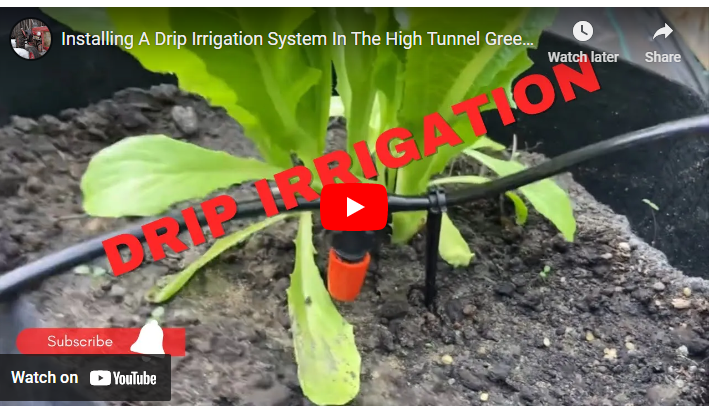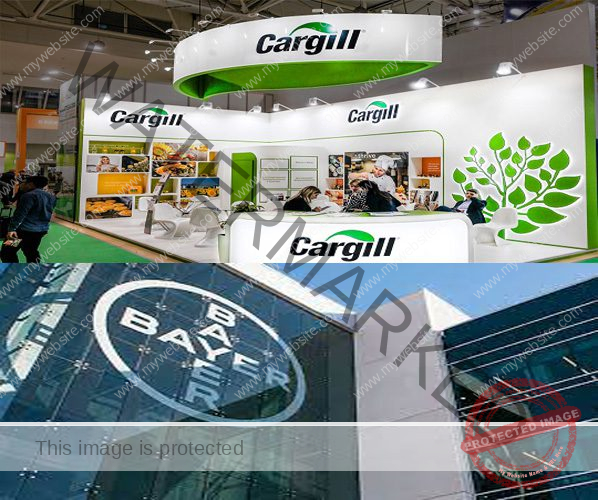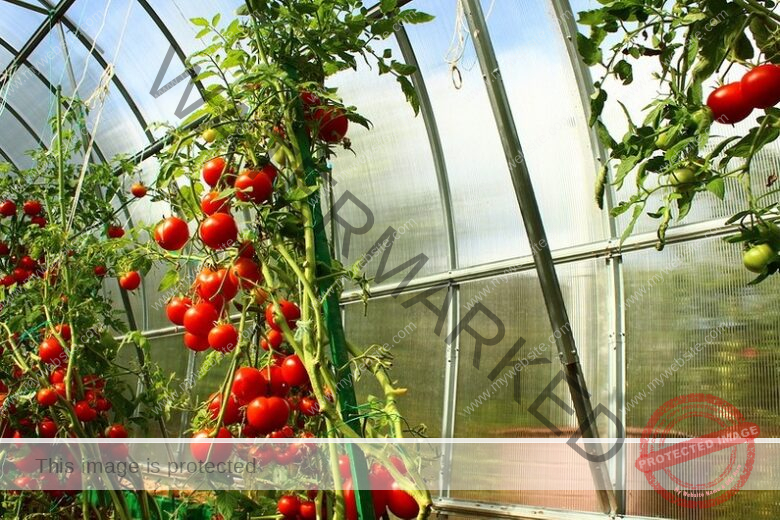A drip irrigation system is a type of irrigation that delivers water directly to the plant’s roots, using a network of pipes and emitters.
This system is widely used in greenhouse farming, where it is crucial to maintain optimal growing conditions to maximize crop yields.
Drip irrigation in greenhouses offers numerous benefits over traditional irrigation methods, such as increased water efficiency, reduced nutrient loss, and improved plant growth and quality.
This system is also more environmentally friendly and cost-effective in the long run, making it an increasingly popular choice for modern greenhouse growers.
Drip Irrigation System In Greenhouse
The drip irrigation system is a simple yet effective way to ensure that your plants receive the right amount of water they need to thrive.
Unlike traditional watering methods that flood the soil with water, drip irrigation delivers water directly to the plant roots in small, controlled amounts.
Read Also: Drip Irrigation System In Africa
A drip irrigation system is a highly efficient way of providing water to plants in a greenhouse.
Unlike traditional watering methods, which involve sprinkling water across a wide area, drip irrigation delivers water directly to the plant’s root system.
This targeted approach ensures that water is used more efficiently, and there is less wastage.
In a greenhouse, where plants are grown in a controlled environment, drip irrigation systems are particularly effective.
Read Also: List of Irrigation Schemes In Ghana
They can be easily installed and automated, providing a consistent supply of water to plants without the need for manual intervention.
This means that plants can be watered on a schedule, even when the greenhouse is unoccupied, ensuring that they receive the right amount of water at the right time.
Drip irrigation systems work by delivering water through a network of tubes that are placed beneath the plants.
These tubes are fitted with small drip emitters that release water at a slow, steady rate directly onto the soil around the plant’s roots.
This ensures that the water is absorbed directly by the plants, minimizing the risk of evaporation or runoff.
Read Also: List of Irrigation Schemes in Africa
One of the primary benefits of a drip irrigation system in a greenhouse is that it can be tailored to meet the specific needs of different plants.
For example, plants that require more water can be supplied with a higher flow rate, while those that need less can be given a lower rate.
This ensures that each plant receives the right amount of water, which is essential for healthy growth.
Another advantage of drip irrigation systems in greenhouses is that they can be used to deliver nutrients and fertilizers directly to the plants.
Read Also: Drip Irrigation System Ghana [Installation Guide ]
By adding these nutrients to the water supply, plants can receive a consistent, targeted dose of the nutrients they need for optimal growth.
This can help to reduce waste and improve the efficiency of the growing process.
Types of Drip Irrigation System In Greenhouse
If you are planning to install a drip irrigation system in your greenhouse, you should know that there are several types of systems to choose from.
Each type has its advantages and disadvantages, and the choice will depend on your specific needs and preferences.
Here are some of the most common types of drip irrigation systems in greenhouses:
Read Also: 12 Factors to Consider When Starting A Farm [Complete Guide]
#1. Surface drip irrigation system
This is the most common type of drip irrigation system used in greenhouses. It involves placing the drip emitters on the surface of the soil, near the plants.
A surface drip irrigation system delivers water to plants through drip emitters placed on the surface of the soil.
The water drips slowly from the emitters and seeps into the soil around the plants. This method is ideal for crops that require low to medium water volumes, and it is relatively simple to install and maintain.
Surface drip irrigation systems are relatively simple to install and maintain, and they are ideal for crops that require low to medium water volumes.
#2. Subsurface drip irrigation system
This type of system involves placing the drip emitters underground, below the soil surface. The water is delivered directly to the roots of the plants, reducing water loss through evaporation or runoff.
Subsurface drip irrigation system delivers water to plants through drip emitters placed underground, below the soil surface.
The water is delivered directly to the roots of the plants, reducing water loss through evaporation or runoff. This system is more efficient than surface systems, especially for crops with deeper root systems. Installation and maintenance can be more expensive than surface systems.
Subsurface drip irrigation systems are more expensive to install than surface systems, but they can be more efficient in terms of water usage and can be beneficial for crops with deeper root systems.
#3. Micro-Irrigation System
A micro-irrigation system is a variation of the drip irrigation system that uses small spray heads or micro-sprinklers to deliver water to plants.
The water is delivered as a fine mist, reducing water loss through evaporation and delivering a consistent supply of water to the plants.
This type of system is ideal for greenhouse crops that require higher water volumes and for overhead irrigation.
Micro-irrigation systems are easy to install and maintain and can be used for a variety of crops.
#4. NFT (Nutrient Film Technique) Drip Irrigation System
NFT drip irrigation system circulates a thin film of nutrient-rich water along a sloping channel or pipe.
The plants are grown in the channel, and the roots draw nutrients directly from the water film.
NFT drip irrigation systems are ideal for hydroponic greenhouse systems, as they provide a continuous supply of nutrients to the plants.
#5. Fertigation Drip Irrigation System
Fertigation systems are a combination of drip irrigation and fertilization. The system delivers a precise amount of water and nutrients to the plants through the drip emitters.
Fertigation drip irrigation systems are ideal for greenhouse crops that require frequent fertilization and are highly efficient in terms of nutrient and water usage.
Best Practices of using Drip Irrigation System
When it comes to using a drip irrigation system in your greenhouse, there are several best practices you should keep in mind to ensure optimal performance and plant growth.
Here are some of the best practices to follow:
- Monitor water quality: Drip irrigation systems are sensitive to clogging and blockages. Therefore, it’s important to ensure that the water you use is of high quality and free from debris or contaminants. Regularly test and monitor your water quality to prevent clogging of the system.
- Proper system design: It’s important to design your drip irrigation system properly to ensure even water distribution to all plants. Make sure the system is designed based on the specific needs of your greenhouse crops, taking into account factors such as plant spacing, soil type, and water requirements.
- Regular maintenance: Regular maintenance of your drip irrigation system is crucial to prevent clogging, blockages, and leaks. Clean the filters regularly, flush the system periodically, and check for damaged or broken parts. Repair or replace any damaged parts immediately to prevent water loss and plant stress.
- Timing and frequency: The timing and frequency of watering are important factors to consider when using a drip irrigation system. Overwatering can lead to plant stress and disease, while underwatering can cause stunted growth and poor yields. Adjust the watering schedule based on the specific needs of your crops, taking into account factors such as temperature, humidity, and stage of growth.
- Use of pressure regulators: Pressure regulators are essential components of a drip irrigation system. They help maintain a consistent water flow and prevent the system from over- or under-pressurizing. Install pressure regulators at the beginning of the system to ensure proper water flow and avoid damage to the system.
Measures to Maintain Drip Irrigation System
There are also several measures you can take to maintain your drip irrigation system:
- Regularly check for leaks and blockages: Check your drip irrigation system regularly for leaks and blockages. Look for signs of water pooling or dripping, and check the emitters for blockages or clogs.
- Inspect the system components: Inspect all components of the system, including the tubing, filters, and emitters, for damage or wear and tear. Replace any damaged parts immediately to prevent water loss and maintain optimal system performance.
- Clean the system regularly: Flush the system regularly to prevent blockages and remove any debris or sediment that may have accumulated in the tubing. Clean the filters and emitters regularly to prevent clogging.
- Winterize the system: If you live in an area with freezing temperatures, make sure to winterize your drip irrigation system before the cold weather sets in. Drain the system of water and store the components in a dry, protected area until spring.
Tips to Select the Right Irrigation System
When selecting an irrigation system for your greenhouse, there are several factors to consider, including the type of crops you grow, the size of your greenhouse, your water source, and your budget.
Here are some tips to help you select the right irrigation system for your needs:
- Determine your water source: Before selecting an irrigation system, it’s important to determine your water source. If you have access to a reliable and adequate water supply, you may choose a system that requires a higher flow rate. If water is scarce, a low-flow system such as drip irrigation may be a better option.
- Consider your crop needs: Different crops have different water requirements. Some crops need more frequent watering, while others can tolerate drought conditions. Consider the water needs of your crops when selecting an irrigation system.
- Evaluate your greenhouse size: The size of your greenhouse will also influence the type of irrigation system you choose. For smaller greenhouses, a manual irrigation system may suffice, while larger greenhouses may require an automated system.
- Budget considerations: Irrigation systems can vary greatly in cost. Consider your budget when selecting a system, and weigh the cost against the potential benefits and savings in water and labor.
Advantages of Drip Irrigation System In Greenhouse
- Water efficiency: Drip irrigation systems are highly water-efficient and can reduce water consumption by up to 60% compared to conventional irrigation methods. This is because water is delivered directly to the roots of the plants, minimizing evaporation and runoff.
- Precision watering: Drip irrigation systems can deliver water precisely where it’s needed, reducing the risk of over- or under-watering. This can help prevent water stress and improve plant growth and yields.
- Labor savings: Drip irrigation systems require less labor than other irrigation methods since they don’t require manual watering or frequent adjustments.
- Reduced disease risk: Drip irrigation can help reduce the risk of plant diseases since the foliage remains dry, reducing the potential for fungal growth.
Disadvantages of Drip Irrigation System In Greenhouse
- Clogging: Drip irrigation systems are prone to clogging, particularly in areas with hard water or high levels of sediment. Regular maintenance and cleaning are essential to prevent blockages and maintain system performance.
- Upfront costs: Drip irrigation systems can be more expensive to install than other irrigation methods. However, the long-term savings in water and labor costs can outweigh the initial investment.
- System design: Proper system design is crucial to ensure even water distribution to all plants. Poor design can lead to uneven watering, plant stress, and reduced yields.
- Potential for water loss: Drip irrigation systems can experience water loss due to leaks, damage, or improper maintenance. Regular inspection and repair are essential to prevent water loss and maintain system efficiency.
Costs of Drip Irrigation System In Greenhouse
When considering a drip irrigation system for your greenhouse, it’s important to understand the costs involved.
Here are some factors that can impact the cost of a drip irrigation system:
- Greenhouse size: The size of your greenhouse will have a significant impact on the cost of the drip irrigation system. A larger greenhouse will require more materials, such as tubing and fittings, and more labor to install the system.
- System components: The components of the drip irrigation system, such as the tubing, fittings, emitters, and valves, will also impact the cost. Higher-quality components will generally be more expensive but can provide better performance and durability.
- Water source: The cost of the drip irrigation system can also be influenced by your water source. If you need to install a new water line or pump, this can add significant costs to the installation.
- System design: Proper system design is crucial for effective and efficient irrigation. A well-designed system can prevent water waste and ensure even distribution of water to all plants. However, the cost of system design may also add to the overall cost of the system.
- Installation labor: The cost of installation labor can vary depending on the complexity of the system and the experience of the installer. If you have experience with irrigation system installation, you may be able to save money by installing the system yourself.
So, how much can you expect to pay for a drip irrigation system in your greenhouse? Costs can vary widely depending on the factors listed above, but here are some general estimates:
- A basic drip irrigation system for a small greenhouse can cost anywhere from $500 to $1,000.
- For a larger greenhouse, the cost can range from $1,000 to $5,000 or more.
- Upgrading to high-quality components and a more complex system design can add several thousand dollars to the overall cost.
Greenhouse Solar Watering System
A greenhouse solar watering system uses solar panels to power the watering system.
This type of system is particularly useful for remote greenhouses or greenhouses that are not connected to the grid.
The solar panels charge a battery, which in turn powers the watering system. This type of system is generally low-maintenance and eco-friendly.
However, it can be costly to install and may not provide enough power for large commercial greenhouses.
Commercial Greenhouse Irrigation Systems
Commercial greenhouse irrigation systems are designed for large-scale operations.
These systems often use computer-controlled automation and high-volume pumps to ensure that all plants receive water on a regular schedule.
The cost of these systems can vary depending on the size of the greenhouse and the complexity of the system.
Commercial greenhouse irrigation systems may require a professional installation and ongoing maintenance.
Best Drip Irrigation System for Greenhouse
The best drip irrigation system for your greenhouse will depend on the size of your greenhouse and the types of plants you are growing.
Some factors to consider when selecting a drip irrigation system include the flow rate of the system, the type of emitters used, and the spacing of the emitters.
Look for a system that is easy to install and maintain, and that provides even watering to all plants in the greenhouse.
Greenhouse Watering Systems DIY
If you are handy and want to save money, you can install a DIY greenhouse watering system. This can be as simple as using a soaker hose or as complex as building a custom drip irrigation system.
There are many online tutorials and resources available to help you design and install your own system.
However, keep in mind that DIY systems may not be as efficient or effective as professional systems, and may require more ongoing maintenance.
Automatic Greenhouse Watering System
An automatic greenhouse watering system can save time and ensure that all plants receive water on a regular schedule.
These systems use timers, sensors, and computer-controlled automation to water the plants at set intervals.
The cost of an automatic watering system can vary depending on the size of the greenhouse and the complexity of the system. Some systems may require professional installation and ongoing maintenance.
Hoop House Irrigation System
A hoop house is a type of greenhouse that is constructed using hoops and plastic sheeting. Hoop house irrigation systems can be similar to traditional greenhouse systems, using drip irrigation or soaker hoses.
However, hoop house irrigation systems may need to be designed differently to account for the unique shape and size of the hoop house.
Some hoop houses may also require manual watering or watering using a hose due to their size or location.
Conclusion
A drip irrigation system is an efficient and effective way to water plants in a greenhouse. It allows for precise control over water usage and reduces the risk of disease and nutrient leaching. Proper maintenance and installation are crucial to ensuring the system’s longevity and effectiveness, and careful consideration should be given to selecting the appropriate system for your specific greenhouse needs.




